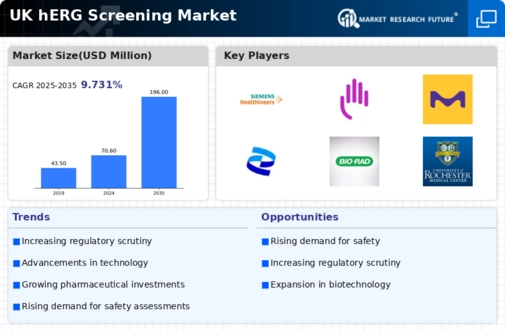Growing Focus on Personalized Medicine
the hERG screening market is being influenced by the rising emphasis on personalized medicine., which aims to tailor treatments to individual patient profiles. This shift necessitates a deeper understanding of drug interactions and potential side effects, particularly concerning cardiac health. As healthcare providers in the UK increasingly adopt personalized approaches, the demand for comprehensive herg screening is likely to rise. The market is projected to grow by approximately 10% annually as pharmaceutical companies seek to develop targeted therapies with minimized cardiac risks. This trend underscores the importance of herg screening in ensuring that personalized medicine strategies are both effective and safe for patients, thereby enhancing the overall value of the herg screening market.
Increased Investment in Drug Development
Investment in drug development is a critical driver for the herg screening market, particularly in the UK, where pharmaceutical companies are allocating substantial resources to research and development. The UK government has been supportive of innovation in the life sciences sector, providing funding and incentives for companies to enhance their drug discovery processes. As a result, the herg screening market is likely to benefit from increased funding, which is expected to exceed £1 billion in 2025. This influx of capital may facilitate the adoption of advanced screening technologies and methodologies, thereby improving the efficiency and accuracy of herg screening processes. Consequently, the herg screening market is poised for growth as companies strive to bring safer drugs to market.
Rising Demand for Cardiotoxicity Testing
The herg screening market is experiencing a notable increase in demand for cardiotoxicity testing, driven by the growing awareness of drug-induced cardiac risks. Regulatory bodies in the UK are emphasizing the importance of assessing the safety profiles of new pharmaceuticals, particularly those targeting the cardiovascular system. This heightened focus on patient safety is likely to propel the market forward, as pharmaceutical companies seek to comply with stringent regulations. In 2025, the market for cardiotoxicity testing is projected to reach approximately £300 million, reflecting a compound annual growth rate (CAGR) of around 8%. This trend indicates a robust growth trajectory for the herg screening market, as stakeholders prioritize the identification of potential cardiac liabilities in drug development.
Regulatory Pressure for Comprehensive Testing
Regulatory pressure for comprehensive testing is a significant driver for the herg screening market in the UK. Authorities are increasingly mandating thorough evaluations of drug candidates to ensure their safety profiles, particularly concerning cardiac effects. This regulatory landscape compels pharmaceutical companies to invest in robust herg screening processes to meet compliance requirements. As a result, the hERG screening market is expected to grow by approximately 6% annually, as companies strive to align with evolving regulations. The emphasis on comprehensive testing not only enhances patient safety but also fosters a culture of accountability within the pharmaceutical industry, thereby reinforcing the importance of herg screening in the drug development pipeline.
Emergence of Innovative Screening Technologies
the hERG screening market is witnessing a transformation due to the emergence of innovative screening technologies. Advancements in high-throughput screening and in silico modeling are enabling more efficient and accurate assessments of drug candidates. In the UK, research institutions and biotech companies are collaborating to develop cutting-edge tools that enhance the predictive capabilities of herg screening. These innovations are expected to reduce the time and costs associated with drug development, potentially saving the industry millions of pounds. As these technologies gain traction, the herg screening market is likely to expand, with an anticipated growth rate of 7% over the next five years. This evolution reflects the ongoing commitment to improving drug safety and efficacy through enhanced screening methodologies.






















Leave a Comment